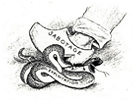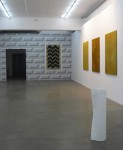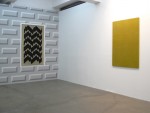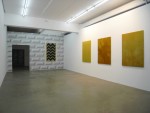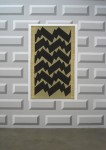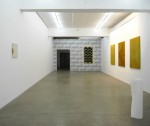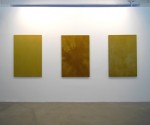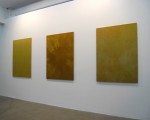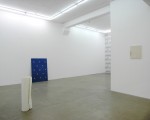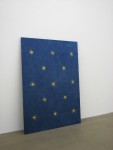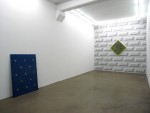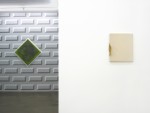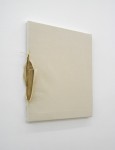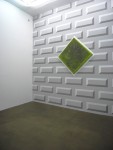ALICE TOMASELLI
Fracas in a brothel
October 4th - November 9th, 2013
opening Friday, October 4th, 7 - 10 p.m.
We are delighted to invite you to Alice Tomaselli's second solo show with Sabot, an exposé of the artist’s daily gymnastics: collect, archive, understand, appreciate, digest the world along with all its cultural tokens.

THE EPISTEMOLOGICAL MARRIAGE
AFTER THE DIVORCE OF ART AND ANTHROPOLOGY.
THE AFFECTIVE LABOUR OF ALICE TOMASELLI.
by Tudor Vlădescu
September 2013
It is quite fashionable right now for a university payroll anthropologist to cry about the insignificances of the fieldwork, as the methodology established during the early or mid-twentieth century has been rendered obsolete by a modern life governed by technology and communication devices. It is also common for a marketed artist to get support and inspiration from one and only one neighbouring, yet not too near, scientific or quasi-scientific disciplines like political sciences, sociology, anthropology, history and the lot. Alice Tomaselli is neither of the two. She is re-defining the anthropological "thick description", thus recovering the resources of fieldwork, and she is also pick-choosing her references with epistemologically blasphemous freedom from any field of social sciences she sees fit. Ethnography and art got divorced somewhere in the early twentieth century, when artworks became exclusively 'objects' to be exiled in museums. In response to that, Alice Tomaselli chose to be an amateur anthropologist and a 'kitchen' artisan. Luckily, she doesn't follow recipe patterns in neither of the two fields. That is to say that she sucks at both taken separately. She goes pro only on both simultaneously.
Three days after I got the first keywords for this article, just before I cast the first glance at Alice Tomaselli's work, I made a blind bet. I knew it was something to do with art. I knew it was something to do with anthropology. And as I myself have once - and still am - trying to forcibly marry the forgotten and fuzzy propaganda novels of the 1960s and the still fashionable and scientific anthropological methodology, mostly with dismaying results caused by opposition from both - humanities and social sciences - sides, I felt almost sure that the work I was about to look at was something that bore the signs of a donquixotesque assault on the cultural establishment.
I was right. Alice Tomaselli's work was donquixotesque, niched towards the hardcore Occupy Movement members, those that travel or want to travel. But it was also coated in a thick layer of anti-sarcasm. And it used as fulcrum the best and only possible support for quality work: the first person singular. The Greeks should have had a name for this. Probably τέχνη εαυτός ανθρωπολογικός (auto-anthropological art). And it should also be described academically something in the line of: the ethnographic study of the local rather than the global mixed with a strong sensitivity to the artist's own emotions. This re-invented discipline would look very much like a safe caveat to our contemporary epistemological crisis. It is re-invented because art used to do just that before art and social sciences went taxonomically distinct. Before World War Two, even economy was listed among arts, for God's sake! In our case, auto-anthropological art is illustrated, for instance, by Alice Tomaselli's 'gold paintings', a series of three Suprematist one-colour canvases that would be automatically interpreted as pure anti-capitalist manifestos in the line of anti-glamour materialism. They could remain just that, unless we dig the manufacturing supporting story under each of them: dyed in the kitchen, using spices that the artist-auto-anthropologist chose as codes. A perfume of Milan - dear homeland, the aroma of popular food in Japan - exotic temporary residence and, finally, a scent from India - next desired destination.
For an auto-anthropologist living in Japan, the expected pool of references would be limited to bushido, sake, shinshukyo, karaoke, fugu, manga, ramen soup, karate, tea or tatami. In Alice Tomaselli's case, it was tatami. But she went further and didn't resist the urge to include history in her cross-disciplinary basket of personalized histories. Some of her works are predictably to do with the East-West cultural dialogue, and this brings immediately up the figure of Marco Polo, the most famous long 13th century Italian and the second most famous long 13th century historical figure after Genghis Khan. And if Genghis Khan is so far not included in Alice Tomaselli's list of referenced celebrities from pre-Renascentist times, the third most important is: Giotto. What strikes me is that Alice Tomaselli's concept of the "conceptually artisanal" was probably used by Giotto's critics or even by Giotto himself describing his own jump in style from the dark and ascetic Byzantine Gothic to the living, yet haunting, early Italian Renaissance.
In one of her workshops, inspired by a WW2 book, Alice Tomaselli has once conducted a course on how to cook from leftovers in the fridge. In preparation of which, she knitted her own poster. As a true auto-anthropologist, she immediately coined a concept for that: the "affective labour". Basically, she wants to research scientifically her own present life, past, and even future. Her works are surprising only in context, as a 'bitten' white canvas has a meaning only if it comes together with other monocolour or monomaterial canvases that ask for the public to come closer, closer, and closer, looking for a hidden design or pattern. Which is not in the work itself, but in the story behind it. I don't know if the stories will accompany the works. But they should. Because it would be a pity not to know that a pattern on one of her works was made using only toilet paper.
-
Tudor Vlădescu holds a PhD (UniBuc) in philology and an MA in cultural anthropology (SNSPA Bucharest). He is a freelance lecturer, currently working on Writing and Composition with the Culinary Institute of America, Singapore and the European Culture and Civilization with the Singapore Institute of Technology. When he is not contributing to the education of his two daughters, Tudor Vlădescu works in cultural history and cultural anthropology, specializing in propaganda studies of the 19th and 20th centuries as well as commonland property issues. His ongoing projects involve the "invisible heritage", an exploration on oral history narratives, residual artefacts or even plants that survived after heritage buildings or other monuments have been destroyed.
